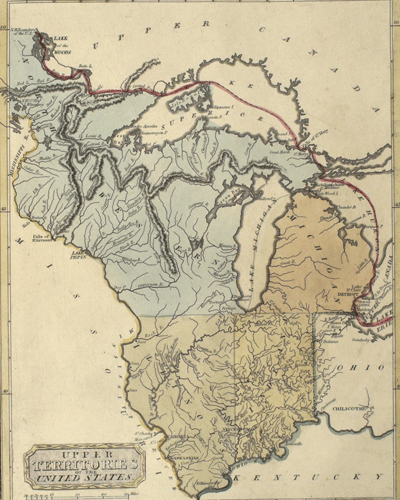
In 1778 American revolutionary George Rogers Clark, defending colonial interests in the Northwest, claimed the sparsely populated Illinois country for Virginia. Following the American Revolution, Illinois fell within the boundaries of the Northwest Territory and operated under the Northwest Ordinance of 1787.
Settlement in this region increased, and on March 1, 1809, Illinois Territory was officially established with its capital at Kaskaskia. This sparked a wave of settlement, with most migrants hailing from the southern United States. Their influence was immediate and lasting. Not only would the territorial government select its laws from among the existing laws of the southern states, but the southern heritage of territorial residents would affect the slavery debate and political climate for decades.
Under the Northwest Ordinance, the vote was restricted to property owners, but because few property owners with substantial land claims resided in Illinois Territory, a referendum was soon adopted granting suffrage to all white taxpaying males who had lived in the territory for at least one year. In October 1812, members of the first legislature, as well as the first territorial representative to the United States Congress, Shadrach Bond, were elected by popular vote.
On December 3, 1818, after exaggerating population totals, Illinois became the twenty-first state admitted to the Union. The capital first remained at Kaskaskia, but it moved to Vandalia in 1819 and to Springfield in 1837. As a state, Illinois adopted a constitution that defined three branches of government marked by a strong bicameral legislature known as the General Assembly. This body, composed of the Senate and House of Representatives, met biennially. Members of the House were elected annually for each assembly. Senators served four-year terms, with half of the legislative body elected every two years. The General Assembly had the power to impeach, counted gubernatorial votes, appointed many state and local officials, and elected the four state supreme court justices, who made up the early judiciary.
The governor was elected biennially by popular vote, but the powers of this office were limited. Under the constitution of 1818, the governor possessed the power of veto only as a single vote in the Council of Revision, a separate body that consisted of the governor and the justices on the state supreme court; the Council was usually neutralized by the overarching powers of the General Assembly. The governor would not gain sole power of the veto until 1848.
The Illinois constitution of 1818 also gave the vote to white male inhabitants over twenty-one who had resided in the state for six months. In the early years of state government, debate surrounded the general election process. In 1819 and 1823, provisions were made for voting to take place via ballot, whereas in 1821 and 1829, viva voce voting was implemented. Viva voce eventually disappeared as population and polling places increased.
Prior to 1830, local factions dominated Illinois party politics. The Harrison faction and the anti-Harrison, or Edgar-Morrison, faction were both pro-slavery but differed in approach. The Edwards and anti-Edwards factions, which sparred over patronage and the judiciary, soon replaced the Harrison factions. When anti-slavery Governor Edward Coles was elected in 1822, a fierce debate began, which gave rise to the Jacksonian politicians who would dominate Illinois politics in the ensuing years.
Bibliography
- Alvord, Clarence Walworth.
The Illinois Country: 1673–1818. Chicago: University of Illinois Press, 1987. Originally published as Volume 1 of the Centennial History of Illinois by the Illinois Centennial Commission, 1920. - Biles, Roger.
Illinois: A History of the Land and Its People. Dekalb: Northern Illinois University Press, 2005. - Boggess, Arthur Clinton.
The Settlement of Illinois, 1778–1830. Chicago: The Chicago Historical Society, 1908. - Buck, Solon J.
Illinois in 1818. Chicago: University of Illinois Press, 1967. - Davis, James E.
Frontier Illinois. Indianapolis: Indiana University Press, 1998. - Leichtle, Kurt E.
"The Rise of Jacksonian Politics in Illinois." Illinois Historical Journal, 82 (Summer 1989): 93–107. - Pease, Theodore Calvin.
The Frontier State: 1818–1848. Chicago: University of Illinois Press, 1987. Originally published as Volume 2 of the Centennial History of Illinois by the Illinois Centennial Commission, 1918. - Pease, Theodore Calvin and Marguerite Jenison Pease.
George Rogers Clark and the Revolution in Illinois: 1763–1787. Springfield: The Illinois State Historical Library and The Illinois State Historical Society, 1929. - Simeone, James.
Democracy and Slavery in Frontier Illinois: The Bottomland Republic. Dekalb: Northern Illinois University Press, 2000. - Sorensen, Mark W. "The Illinois History Resource Page." Illinois State Historical Society, December 12, 1995."The Illinois History Resource Page."
- Sutton, Robert M.
"Edward Coles and the Constitutional Crises in Illinois, 1822–1824." Illinois Historical Journal, 82 (Spring 1989): 36–46. - Sutton, Robert P., ed.
The Prairie State: A Documentary History of Illinois, Colonial Years to 1860. Grand Rapids: William B. Eerdmans, 1976.






